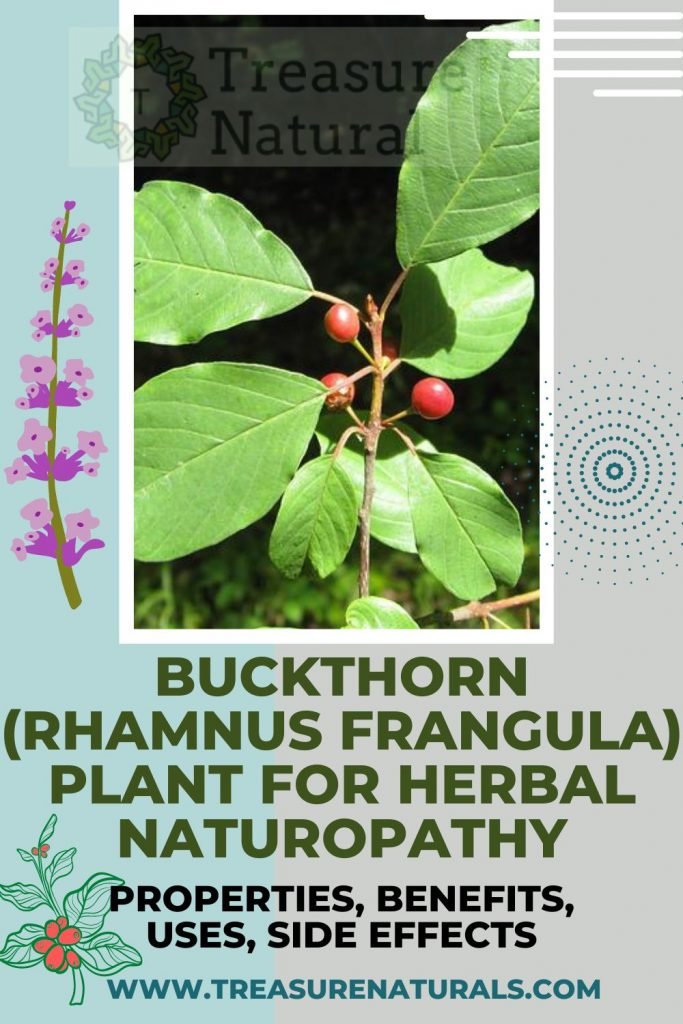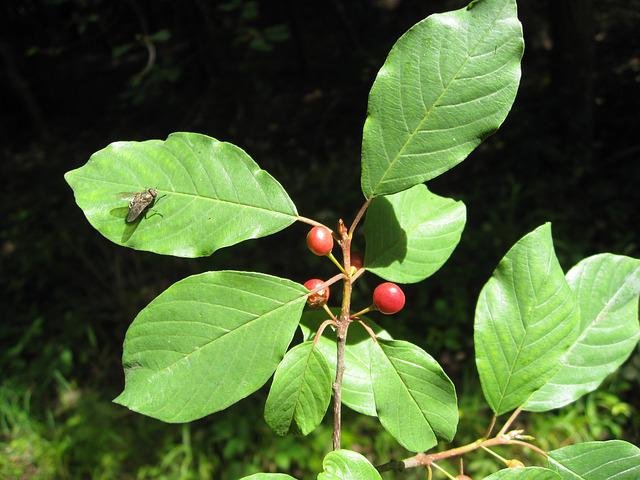
Buckthorn (Rhamnus frangula) is a plant of the Rhamnaceae family. Known for its laxative properties, it is excellent for stimulating peristalsis. Let’s find out better.
Properties of buckthorn
Buckthorn bark contains anthraquinone glycosides, which stimulate intestinal peristalsis. These active ingredients are poorly absorbed in the stomach and small intestine; while in the large intestine they are metabolized becoming biologically active, thanks to the ability of the bacterial flora to transform them into anthrons, responsible for the laxative property of the plant. In fact, glycosides manifest their activity only after the bacteria of our flora have hydrolyzed them, releasing the aglycones and transforming these into the active form, the antrones.
This explains the period of time, which passes between the intake of the extract and the manifestation of the purgative action, which can be up to 12-16 hours. Anthraquinones also reduce the reabsorption of water, sodium and chlorine by the intestinal mucosa, allowing greater hydration of the fecal mass and therefore of the volume and softness of the stool itself.
The most important active ingredient of buckthorn is given by frangulin, a sovereign substance in the treatment of occasional or chronic constipation. Unlike many other natural or artificial laxatives, the buckthorn bark has the gift of restoring the tone to the muscle fibers of the intestine, stimulating peristalsis in a gentle way.
For this reason it is not irritating or addictive, so even prolonged use is less harmful than other natural laxatives. Buckthorn is indicated in cases where the stool must be soft, in all those situations in which the natural physiological process of evacuation can be made particularly difficult and painful by swollen and inflamed veins in the area of the anus: in the presence of fissures, hemorrhoids and after rectal surgery.
Its intake is also indicated for those who have previously used very strong laxatives and on which intestinal inertia (lazy intestine) depends, in the treatment of chronic constipation in the elderly, and when it is necessary to have soft stools and easy defecation.
How to use
INTERNAL USE
DECOCT: 1 level teaspoon of buckthorn root, 1 cup of water
Pour the chopped root into cold water, turn on the heat and bring to a boil. Boil for a few minutes and turn off the heat. Cover and leave to infuse for 10 min. Filter the infusion and drink it after the evening meal to take advantage of the laxative action.
Contraindications of buckthorn
As with any other laxative, prolonged use is not recommended, because it can cause lazy bowel syndrome, i.e. addiction to laxative principles with consequent inability to move the stool in the absence of external chemical stimulation. Overdose causes diarrhea with abdominal pain and loss of fluids and potassium.
It is contraindicated in pregnancy, in children under 12 years of age, in breastfeeding, in intestinal diverticulosis, in patients with intestinal obstruction or sub-occlusion, in patients with perianal fistulas.
Description of the plant
Shrub (2–3 m) generally with a few alternate branches developed mostly at the ends, it has a gray-purplish or lead-gray bark, with numerous round gray-white lenticels in the young branches and transversely elongated in the old ones. The leaves are alternate deciduous, with elliptical, obtuse or more often sharp lamina, with 8 nerves per side and entire margin.
Adults are hairless when young, slightly hairy like the very young branches and buds. The flowers are small collected in axillary bundles of 2-6, hermaphroditic, with 5 yellowish-white petals. The ripe fruits are small bluish-black drupes of 6-7 mm, spherical, a little wider than long, with a yellow, almost round, flattened seed per loggia, with a leathery integument.
The habitat of the buckthorn
Buckthorn is native to Europe and Asia and frequently grows on moors along watercourses; in humid deciduous forests on preferably acid soils.
Background

In ancient times the coal obtained from buckthorn was used to produce excellent smoke gunpowder especially in Eastern European countries, while in the Bolognese area the twigs were used to produce pipe straws.






